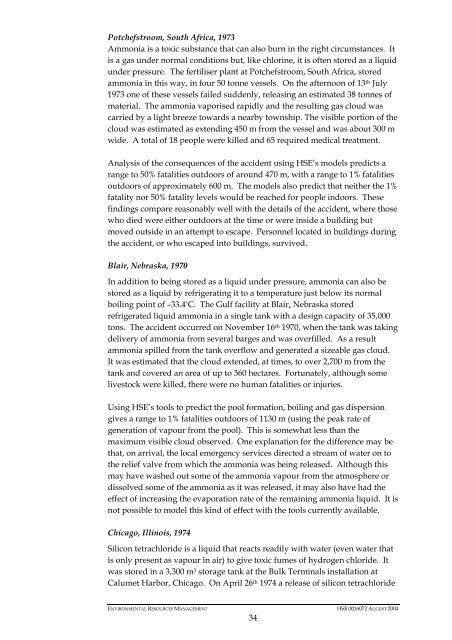A review of HSE's risk analysis and protection-based analysis ...
A review of HSE's risk analysis and protection-based analysis ...
A review of HSE's risk analysis and protection-based analysis ...
You also want an ePaper? Increase the reach of your titles
YUMPU automatically turns print PDFs into web optimized ePapers that Google loves.
Potchefstroom, South Africa, 1973<br />
Ammonia is a toxic substance that can also burn in the right circumstances. It<br />
is a gas under normal conditions but, like chlorine, it is <strong>of</strong>ten stored as a liquid<br />
under pressure. The fertiliser plant at Potchefstroom, South Africa, stored<br />
ammonia in this way, in four 50 tonne vessels. On the afternoon <strong>of</strong> 13 th July<br />
1973 one <strong>of</strong> these vessels failed suddenly, releasing an estimated 38 tonnes <strong>of</strong><br />
material. The ammonia vaporised rapidly <strong>and</strong> the resulting gas cloud was<br />
carried by a light breeze towards a nearby township. The visible portion <strong>of</strong> the<br />
cloud was estimated as extending 450 m from the vessel <strong>and</strong> was about 300 m<br />
wide. A total <strong>of</strong> 18 people were killed <strong>and</strong> 65 required medical treatment.<br />
Analysis <strong>of</strong> the consequences <strong>of</strong> the accident using HSE’s models predicts a<br />
range to 50% fatalities outdoors <strong>of</strong> around 470 m, with a range to 1% fatalities<br />
outdoors <strong>of</strong> approximately 600 m. The models also predict that neither the 1%<br />
fatality nor 50% fatality levels would be reached for people indoors. These<br />
findings compare reasonably well with the details <strong>of</strong> the accident, where those<br />
who died were either outdoors at the time or were inside a building but<br />
moved outside in an attempt to escape. Personnel located in buildings during<br />
the accident, or who escaped into buildings, survived.<br />
Blair, Nebraska, 1970<br />
In addition to being stored as a liquid under pressure, ammonia can also be<br />
stored as a liquid by refrigerating it to a temperature just below its normal<br />
boiling point <strong>of</strong> –33.4 °C. The Gulf facility at Blair, Nebraska stored<br />
refrigerated liquid ammonia in a single tank with a design capacity <strong>of</strong> 35,000<br />
tons. The accident occurred on November 16 th 1970, when the tank was taking<br />
delivery <strong>of</strong> ammonia from several barges <strong>and</strong> was overfilled. As a result<br />
ammonia spilled from the tank overflow <strong>and</strong> generated a sizeable gas cloud.<br />
It was estimated that the cloud extended, at times, to over 2,700 m from the<br />
tank <strong>and</strong> covered an area <strong>of</strong> up to 360 hectares. Fortunately, although some<br />
livestock were killed, there were no human fatalities or injuries.<br />
Using HSE’s tools to predict the pool formation, boiling <strong>and</strong> gas dispersion<br />
gives a range to 1% fatalities outdoors <strong>of</strong> 1130 m (using the peak rate <strong>of</strong><br />
generation <strong>of</strong> vapour from the pool). This is somewhat less than the<br />
maximum visible cloud observed. One explanation for the difference may be<br />
that, on arrival, the local emergency services directed a stream <strong>of</strong> water on to<br />
the relief valve from which the ammonia was being released. Although this<br />
may have washed out some <strong>of</strong> the ammonia vapour from the atmosphere or<br />
dissolved some <strong>of</strong> the ammonia as it was released, it may also have had the<br />
effect <strong>of</strong> increasing the evaporation rate <strong>of</strong> the remaining ammonia liquid. It is<br />
not possible to model this kind <strong>of</strong> effect with the tools currently available.<br />
Chicago, Illinois, 1974<br />
Silicon tetrachloride is a liquid that reacts readily with water (even water that<br />
is only present as vapour in air) to give toxic fumes <strong>of</strong> hydrogen chloride. It<br />
was stored in a 3,300 m 3 storage tank at the Bulk Terminals installation at<br />
Calumet Harbor, Chicago. On April 26 th 1974 a release <strong>of</strong> silicon tetrachloride<br />
ENVIRONMENTAL RESOURCES MANAGEMENT HSE 0016072 AUGUST 2004<br />
34

















